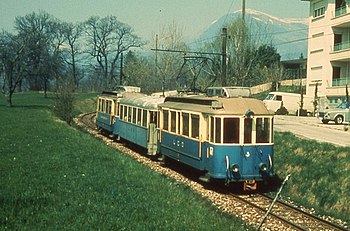Lugano-Cadro-Dino-Bahn
| Lugano – Cadro – Dino | |||||||||||||||||||||||||||||||||||||||||||||||||||||||||||||||||||||||||||||||||||||
|---|---|---|---|---|---|---|---|---|---|---|---|---|---|---|---|---|---|---|---|---|---|---|---|---|---|---|---|---|---|---|---|---|---|---|---|---|---|---|---|---|---|---|---|---|---|---|---|---|---|---|---|---|---|---|---|---|---|---|---|---|---|---|---|---|---|---|---|---|---|---|---|---|---|---|---|---|---|---|---|---|---|---|---|---|---|
|
Train the LCD on the last day of operation
| |||||||||||||||||||||||||||||||||||||||||||||||||||||||||||||||||||||||||||||||||||||
| Route length: | 7.8 km | ||||||||||||||||||||||||||||||||||||||||||||||||||||||||||||||||||||||||||||||||||||
| Gauge : | 1000 mm ( meter gauge ) | ||||||||||||||||||||||||||||||||||||||||||||||||||||||||||||||||||||||||||||||||||||
| Power system : | 1000 V = | ||||||||||||||||||||||||||||||||||||||||||||||||||||||||||||||||||||||||||||||||||||
| Maximum slope : | 40 ‰ | ||||||||||||||||||||||||||||||||||||||||||||||||||||||||||||||||||||||||||||||||||||
| Minimum radius : | 40 m | ||||||||||||||||||||||||||||||||||||||||||||||||||||||||||||||||||||||||||||||||||||
| Top speed: | 55 km / h | ||||||||||||||||||||||||||||||||||||||||||||||||||||||||||||||||||||||||||||||||||||
| Operator: | Ferrovia Elettrica Lugano – Cadro – Dino |
||||||||||||||||||||||||||||||||||||||||||||||||||||||||||||||||||||||||||||||||||||
| Opening: |
Lugano Piazza Manzoni– Viganello : January 2nd, 1911 Viganello– Dino : June 27th, 1911 |
||||||||||||||||||||||||||||||||||||||||||||||||||||||||||||||||||||||||||||||||||||
| Shutdown: |
Lugano Piazza Manzoni– Piazza Indipendenza: November 27, 1967 Lugano Piazza Indipendenza– Dino : May 30, 1970 |
||||||||||||||||||||||||||||||||||||||||||||||||||||||||||||||||||||||||||||||||||||
|
|||||||||||||||||||||||||||||||||||||||||||||||||||||||||||||||||||||||||||||||||||||
The Lugano-Cadro-Dino-Bahn , abbreviated LCD , Italian Ferrovia Lugano-Cadro-Dino , was a meter- gauge narrow - gauge railway - and tram with starting point in the city of Lugano . From there it led in a north-easterly direction via Cadro to Dino .
history
The train was one of four meter-gauge tram or railway companies in and around Lugano. In addition to the Lugano-Cadro-Dino-Bahn, there was the Lugano-Tesserete-Bahn (LT), the Tramvie Comunali di Lugano (TCL) and the Lugano-Ponte-Tresa-Bahn (FLP). Except for the latter, all have ceased operations and have been replaced by buses.
The Lugano-Cadro-Dino-Bahn was put into operation in two stages. The first section between Lugano and Viganello was opened on January 2 and the second section from Viganello to Dino on June 27, 1911. This made it the third of the four railway companies in the city. It began at today's Piazza Indipendenza and had track connections to all four other meter-gauge railways. It was later extended to the lake in Lugano. As a result, the terminus was also closer to the SBB train station , which could be reached with the Lugano – SBB funicular , and the landing stage for the ships.
The track was 7.9 kilometers long and overcame a difference in altitude of 210 meters on this route. There were two tunnels, 96 and 65 meters long, and four bridges on the route . These were 7½, 9, 10 and 26 meters long and all made of steel except for the ten meter long stone bridge .
Since the opening of operations, the LCD has operated the two kilometer long section of its route to La Santa in the city as a tram. The tram trains recently ran in addition to the regional trains every 15 minutes. The tram operation of the LCD was stopped as early as 1964 and replaced by a bus line.
The youngest section of the line was also the first to be discontinued in November 1967. The rest of the route was used until May 30, 1970. From then on, the buses of the Società Autolinee Regionali Luganesi (ARL), which emerged in 1967 from the merger of Lugano-Tesserete-Bahn and Lugano-Cadro-Dino-Bahn, took over passenger transport.
The northern tunnel of the route is now accessible as part of a footpath; the southern tunnel is concreted over at the north portal and the subsequent incision has been filled, on this area there is a parking lot (Via G. Guioni). The southern tunnel is used by the city as a material store.
Vehicle fleet

Railcar
|
|
This list is not up to date with regard to the MOB Be 4/4 1001 "ex LCD Be 4/4 9. See discussion. Corrections are welcome. |
- CFe 2/2 1-4 (1911) SWS / Alioth
- Ce 2/2 5, formerly Ce 2/2 6. Taken over from the Lugano tram in 1913 , adapted by the BBC.
- Ce 4/4 10, formerly Ce 4/4 1 (1937) SIG / BBC. Taken over by the Biel-Meinisberg-Bahn in 1941 , technically related to the Swiss standard car .
- Ce 2/2 6–8, formerly Ce 2/2 2, 5, 3. 1951 taken over by the tramway electtrici mendrisiensi .
- Ce 4/4 9 (1955) Ateliers de constructions mécaniques de Vevey ACMV / SWS / BBC, went to the MOB in 1973 , there as Be 4/4 1001 "in operation.
Passenger cars
- C2 11 (1911) SWS
- C2 21 (1911) SWS
- C 31, taken over by the RhB in 1930
- C4 41–42 (1944–1945)
- C 12, taken over by the electtrici mendrisiensi tramway in 1951
- L 51 (1911) SWS
Trivia
The Cadro stop is probably the only stop in Switzerland that appears in the name of a railway company.
literature
- Alberto Polli, Angelo Ghirlanda: C'era una volta… Fontana Edizioni, Lugano-Pregassona 2010.
- Hans Waldburger: Lugano-Cadro-Dino LCD . In: Railway amateur . No. 6 . SVEA, 2011, ISSN 0013-2764 , p. 282-289 .
- Martin Schweizer, Florian Inäbnit: 100 years of Lugano – Cadro – Dino . In: buffer stop . No. 2 . Buffer stop Druck & Verlag, 2011, ISSN 1660-2986 , p. 16-22 .
Web links
- Map series time travel 1962. In: Map of Switzerland. Federal Office of Topography, accessed on January 26, 2020 .
Individual evidence
- ↑ Eisenbahn Amateur 6/2011, p. 282



